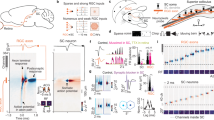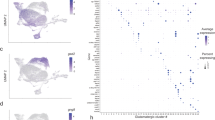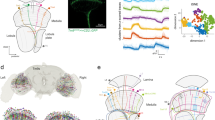Abstract
THE axons of photoreceptors in arthropods project in a precisely ordered manner from the retina to the lamina. As retina and lamina consist of two-dimensional arrays of structural units (the ommatidia and the cartridges, respectively), a particular unit of origin and a specific target unit can be defined uniquely for each axon. In a number of species, such as water fleas1, crabs2 and locusts3, all axons originating from an ommatidium terminate in the same cartridge, where they form synapses onto laminar neurones. How is a particular target cartridge selected by the retinular axons as they grow into the laminar anlage during embryogenesis? The adult pattern of projections could arise in several ways. For example, each ommatidium and each cartridge could have unique chemical labels varying with or according to their positions in their respective domains. Input and target could then be matched by a chemoaffinity mechanism such as that originally proposed by Sperry4 for the formation of vertebrate retinotectal connections. A second possibility is that retinular fibres do not recognise any specific labels in the laminar cells, but grow into this region in the appropriate spatio–temporal order to sequentially fill available sites in a pre-formed laminar array. In a variation of this second mechanism the lamina would be unstructured at the time of arrival of retinular axons and the axons would impose a pattern on the lamina by sequentially recruiting immature laminar neurones to form the regular array of cartridges. These possibilities have been tested by deleting ommatidia at specified developmental stages in Daphnia magna, a small branchiopod crustacean with a total of 22 ommatidia and 22 cartridges1. The observations reported here support the last hypothesis, that the order of retinular axon ingrowth determines the retino–laminar projections in this organism.
This is a preview of subscription content, access via your institution
Access options
Subscribe to this journal
Receive 51 print issues and online access
$199.00 per year
only $3.90 per issue
Buy this article
- Purchase on Springer Link
- Instant access to full article PDF
Prices may be subject to local taxes which are calculated during checkout
Similar content being viewed by others
References
Macagno, E. R., Lo Presti, V. & Levinthal, C. Proc. natn. Acad. Sci. U.S.A. 70, 57–61 (1973).
Stowe, S. Cell Tissue Res. 185, 515–525 (1977).
Horridge, G. A. Nature 219, 737–740 (1968).
Sperry, R. W. Proc. natn. Acad. Sci. U.S.A. 50, 703–710 (1963).
Lo Presti, C., Macagno, E. R. & Levinthal, C. Proc. natn. Acad. Sci. U.S.A. 70, 433–437 (1973).
Lo Presti, V., Macagno, E. R. & Levinthal, C. Proc. natn. Acad. Sci. U.S.A. 71, 1089–1102 (1974).
Macagno, E. R. in Cell Tissue Interactions (eds Lash, J. W. & Burger, M. M.) 293–309 (Raven, New York, 1977).
Levinthal, C., Macagno, E. R. & Tountas, C. Fedn Proc. 33, 2336–2340 (1974).
Power, M. E. J. exp. Zool. 94, 33–71 (1943); Meyerowitz, E. M. & Kankel, D. R. Devl Biol. 62, 112–142 (1978).
Mouze, M. J. Embryol. exp. Morph. 31, 377–407 (1974).
Anderson, H. J. Embryol. exp. Morph. 45, 55–83 (1978).
Nordlander, R. H. & Edwards, J. S. Nature 218, 780–781 (1968).
Cowan, M. W. in Development and Aging of the Nervous System (Academic, New York and London, 1973).
Gottlieb, D. I. & Cowan, W. M. Brain Res. 41, 452–546 (1972).
Gaze, R. M. & Hope, R. A. Prog. Brain Res. 45, 327–357 (1976).
Meinertzhagen, I. A. in Cell Patterning (Elsevier, North-Holland, Amsterdam, 1975).
Author information
Authors and Affiliations
Rights and permissions
About this article
Cite this article
MACAGNO, E. Mechanism for the formation of synaptic projections in the arthropod visual system. Nature 275, 318–320 (1978). https://doi.org/10.1038/275318a0
Received:
Accepted:
Issue Date:
DOI: https://doi.org/10.1038/275318a0
Comments
By submitting a comment you agree to abide by our Terms and Community Guidelines. If you find something abusive or that does not comply with our terms or guidelines please flag it as inappropriate.



